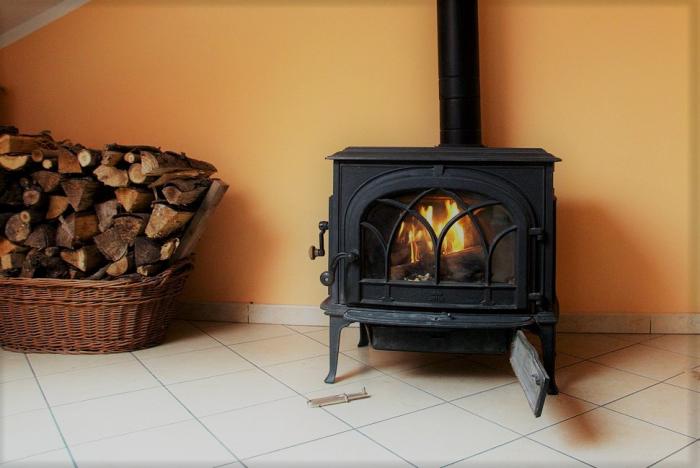
Are wood burning stoves an asset for Part L compliance?
Installing a wood burning stove into new domestic developments can help buildings to achieve compliance with Welsh and English building regulations Part L, by improving the design stage dwelling emissions rate (DER).
Unlike open fires, wood burners can efficiently heat homes by minimising energy losses through the chimney, significantly improving environmental performance in Standard Assessment Procedure (SAP) calculations.
The impact of wood burners
Two notional SAP calculations were completed to demonstrate the impact of a wood burning stove, based on a 100sq m two-story detached house in Wales that uses a gas boiler as its main heating system. The DER of the notional dwelling achieved a 0.1% reduction on the target emission rate (TER), just passing regulations, whilst the same dwelling with the addition of a wood burner (63% efficient) achieved a 5.3% reduction.
The percentage reduction achieved by a wood burning stove can assist in scenarios where a new development does not comply with building regulations at design stage. It can also be used as a means of reducing the reliance on other building elements to meet regulations, such as insulation, air permeability and glazing quality. Installing a wood burner can also prove useful when refurbishing an existing property, especially when particular building fabrics cannot be easily or cheaply changed.
It should be noted that this analysis has only been conducted with reference to Welsh and English buildings and may not apply to other locations.
Why are log burners so efficient?
Wood produces CO2 when it is burned, so why do they perform better than natural gas and coal in SAP calculations? In comparison with fossil fuels, the life cycle of wood is very short, meaning the overall impact on atmospheric CO2 levels is lower, since the tree absorbed CO2 during growth.
Provided the logs used for the burner are sustainably sourced, wood may be seen as a renewable resource that creates no net change in CO2 levels. In a nutshell, when factoring a log burner into SAP calculations, it is assumed that there will be reduced demand on the boiler, meaning less natural gas will be burned to heat the house.
However, although wood burners reduce CO2 emissions on paper, other environmental issues have been raised which may cast doubts over their actual environmental performance. For example, the issue of particulate matter (PM) has been raised, since burning wood produces smoke. The smoke depends greatly on the quality of the wood, and it can be more harmful for the environment if poor quality or damp wood is burned. This is currently a hot topic after London Mayor Sadiq Khan’s recent calls to ban wood burning stoves in London due to localised air pollution. It is important to consider impact on air quality when installing a wood burning stove in an urban area, and it is especially important to establish whether the dwelling is situated in a smoke control area that restricts the burning of solid fuels.
The downsides
On paper, installing a wood burning stove is a logical choice when considering regulations and overall environmental impact. However, there are several issues rooted in potential installations, involving physical and economic constraints.
Firstly, the cost. A mid-range wood burning stove costs between £500 and £1000, which is not that expensive when considering the total building cost of a new dwelling. However, the stove also requires a flue to be built in to the dwelling, which can increase construction costs by thousands of pounds, depending on the dwelling.
These costs may be drastically reduced if installation is factored in during the design stage. It is also worth noting that in the case where a dwelling is achieving a high percentage reduction on the TER, money can be saved on insulation and other elements.
Benefits of log burners
When a building is struggling to pass Part L regulations, the installation of a wood burning stove can provide assurance that the building will pass without having to make costly changes at the as built stage of the process, such as the installation of solar PV roof panels.
Wood burners can also increase the attractiveness for potential homeowners and tenants, since their gas bills could be reduced, potentially increasing the value of the property. As well as being an environmentally friendly addition to any home, these factors illustrate how a wood burning stove can be an attractive prospect for house builders and residential developers, alike.
- Filed Under: Fireplaces and Stoves
- Keywords : Energy Efficiency, Wood Burning Stoves, Part L Compliance
- ( 1519 ) views

GreenBuild Consult provides a comprehensive sustainable consultancy for both commercial and residential developments; combined with our extensive experience and innovative approach ensures sustainability and energy compliance targets are frequently exceeded.
- ( 0 ) Ratings
- ( 0 ) Discussions
- ( 0 ) Group Posts
Reply/Leave a Comment (You must be logged in to leave a comment)
Connect with us!
Subscribe to our monthly newsletter:
 Greenbuild Report Out, 2025 Nov 12, 2025
Greenbuild Report Out, 2025 Nov 12, 2025


























Not a Member Yet? Register and Join the Community | Log in